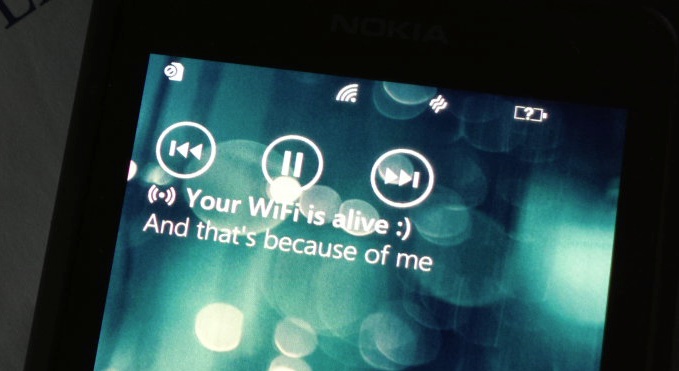Review: Active Wifi
Score:
80%
One of the basic tenets of a modern 'smartphone' is that it should be always connected. Yet this is where Windows Phone has traditionally let itself down slightly, as I shall explain below. Happily, a new utility, Active Wifi, completely solves the problem, so this is one story that has a happy ending (albeit costing you £0.79p)!
Version Reviewed: 1.0
Buy Link | Download / Information Link
How many times has this happened to you? You put your Windows Phone down for a few minutes and then pick it up and unlock the screen. You tap on a web page link or an application that requires connectivity, only to see something like this:

What's happening is that, by default, after a timeout of about ten minutes or so (this possibly varies by device) after you last used the phone, the Windows Phone OS drops the wi-fi connection, in an attempt to save battery power. This is somewhat ironic, since maintaining a cellular data connection is just as likely to be a drain on the phone's power, plus there are substantial power spikes associated with re-establishing a Wi-fi connection.
This behaviour has been a huge factor in keeping me away from Windows Phone as a day to day mobile platform. Delays while all the (non-multitasking) third party applications had to go off every time to gather new data were bad enough, but it seemed as though I also had to deal with a five second delay every time I unlocked the phone screen, while the Wi-fi got hooked up again. Add the two together and a ten second delay before anything happened on screen wasn't uncommon. And extremely annoying.
Other mobile operating systems stay connected via Wi-fi all the time. In fact, every other Wi-fi-capable device in my house does this, so why is Windows Phone being so bloody minded? It's possible that this behaviour may change in Windows Phone 8 late next month, but until then there's now a solution, a great piece of lateral thinking in 'Active WiFi', shown off here. It's a commercial utility in the Windows Phone Marketplace but isn't expensive.
You may remember that we posted about a utility, Keep Alive, a while back, that promised to keep Wi-fi alive - it was slipped into the Marketplace under the guise of being a first aid application, but the pretense has now been dropped and Keep Alive is unashamed at what it tries to do. Sadly, as soon as another application needs the RAM, Keep Alive gets zapped and its functionality is lost. So power users will quickly find themselves without wifi again.
Active WiFi solves this issue by hooking into the music subsystem in Windows Phone. By pretending to be playing a music file (cleverly denoted on the lockscreen by the artist name 'Your WiFi is alive" and track name "And that's because of me"), the OS keeps it alive in the background. Even if the Active WiFi application itself is terminated because of the need for RAM, the background thread that's holding the 'music' file paused is kept going, since that's handled by Windows Phone and isn't subject to the same aggressive restrictions. So the core function of keeping your Wi-fi going still works.

All of which is pretty useful, even if something of a 'hack'. Where Active WiFi comes a cropper, of course, is when something else needs to use the music subsystem, at which point the utility's point of access into the OS is denied. With music playing or even paused, the Wi-fi will time out in the usual way when your screen is keylocked and it's up to you to remember to pop back into Active WiFi at a later date in order to re-enable it. Depending on how much you use music/podcasts (etc.) this may be a showstopping problem.
One oddity I noticed is that, when active, the main power icon in Active WiFi is red (i.e. for 'stop') and, when disabled, the icon is green (i.e. for 'go') - I think the developer might like to rethink his colour methodology?


If this all sounds like a lot of hassle to go through just to potentially save five seconds when you unlock your phone then you could be right. Many users never notice the Wi-fi reconnection delay on Windows Phone, because of the way they use the devices, because of the applications used and data caching, or because they're simply more patient.
However, as someone very used to Symbian and Android, both of which feature full background multitasking, I expect instant response from the phone after I unlock the screen. I want the OS, and both its built-in and third party applications to all ready to go, instantly. Admittedly with the above caveats, Active WiFi helps me get close to this instant connectivity on current Windows Phones and it has earned itself a valuable place in my toolbox for this reason.
Reviewed by Steve Litchfield at
